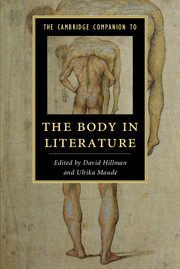14 results
7 - The Unconsoled of The Unconsoled
- from Part II - Literature, Music, and Film
-
-
- Book:
- The Cambridge Companion to Kazuo Ishiguro
- Published online:
- 16 March 2023
- Print publication:
- 23 March 2023, pp 108-122
-
- Chapter
- Export citation
Chapter 10 - “Que voulez-vous?”
- from III - New Hermeneutic Codes
-
-
- Book:
- The New Samuel Beckett Studies
- Published online:
- 17 June 2019
- Print publication:
- 04 July 2019, pp 175-194
-
- Chapter
- Export citation
14 - Literature and Neurology
-
-
- Book:
- The Cambridge Companion to the Body in Literature
- Published online:
- 05 June 2015
- Print publication:
- 19 May 2015, pp 197-213
-
- Chapter
- Export citation
Index
-
- Book:
- The Cambridge Companion to the Body in Literature
- Published online:
- 05 June 2015
- Print publication:
- 19 May 2015, pp 261-272
-
- Chapter
- Export citation
1 - Introduction
-
-
- Book:
- The Cambridge Companion to the Body in Literature
- Published online:
- 05 June 2015
- Print publication:
- 19 May 2015, pp 1-9
-
- Chapter
- Export citation
Copyright page
-
- Book:
- The Cambridge Companion to the Body in Literature
- Published online:
- 05 June 2015
- Print publication:
- 19 May 2015, pp vi-vi
-
- Chapter
- Export citation

The Cambridge Companion to the Body in Literature
-
- Published online:
- 05 June 2015
- Print publication:
- 19 May 2015
Notes on Contributors
-
- Book:
- The Cambridge Companion to the Body in Literature
- Published online:
- 05 June 2015
- Print publication:
- 19 May 2015, pp ix-xii
-
- Chapter
- Export citation
Acknowledgements
-
- Book:
- The Cambridge Companion to the Body in Literature
- Published online:
- 05 June 2015
- Print publication:
- 19 May 2015, pp xiii-xiv
-
- Chapter
- Export citation
Contents
-
- Book:
- The Cambridge Companion to the Body in Literature
- Published online:
- 05 June 2015
- Print publication:
- 19 May 2015, pp vii-viii
-
- Chapter
- Export citation
13 - Beckett, Body and Mind
- from Part III - Topics
-
-
- Book:
- The New Cambridge Companion to Samuel Beckett
- Published online:
- 05 February 2015
- Print publication:
- 12 January 2015, pp 170-184
-
- Chapter
- Export citation
Notes on Contributors
-
-
- Book:
- The New Cambridge Companion to Samuel Beckett
- Published online:
- 05 February 2015
- Print publication:
- 12 January 2015, pp ix-xii
-
- Chapter
- Export citation
Contributors
-
-
- Book:
- The Cambridge Companion to Modernist Culture
- Published online:
- 05 November 2014
- Print publication:
- 27 October 2014, pp xi-xiv
-
- Chapter
- Export citation
2 - Science, Technology, and the Body
- from Part I - Shaping Worldviews
-
-
- Book:
- The Cambridge Companion to Modernist Culture
- Published online:
- 05 November 2014
- Print publication:
- 27 October 2014, pp 33-49
-
- Chapter
- Export citation



